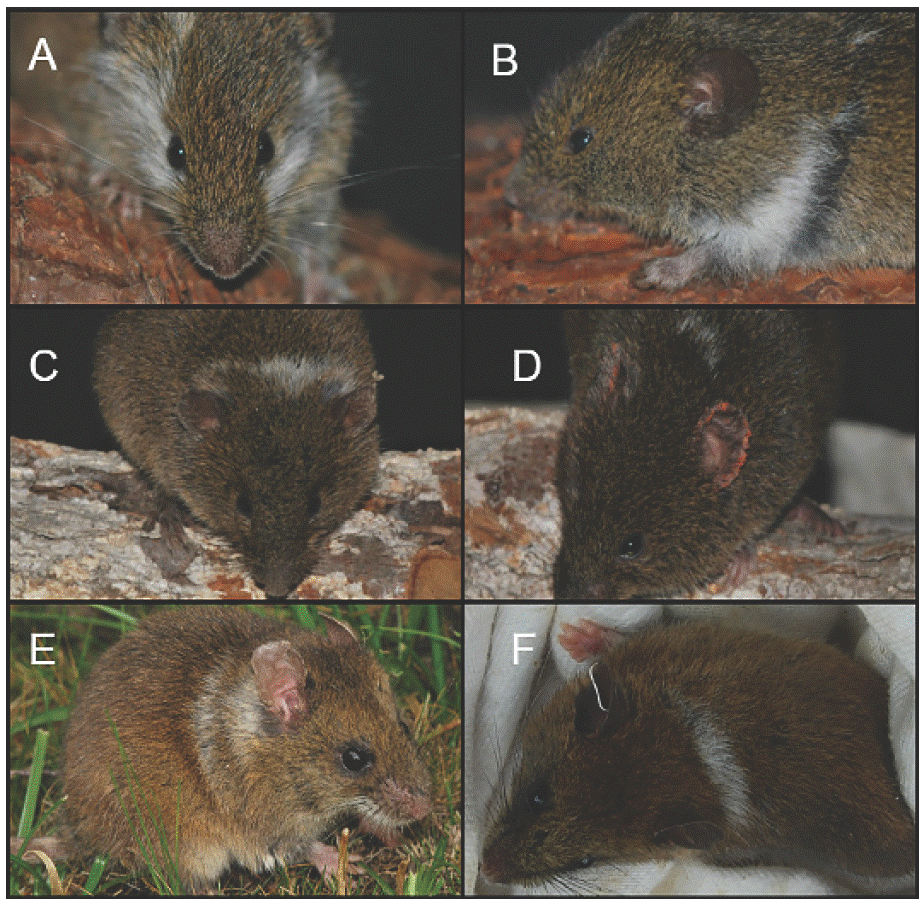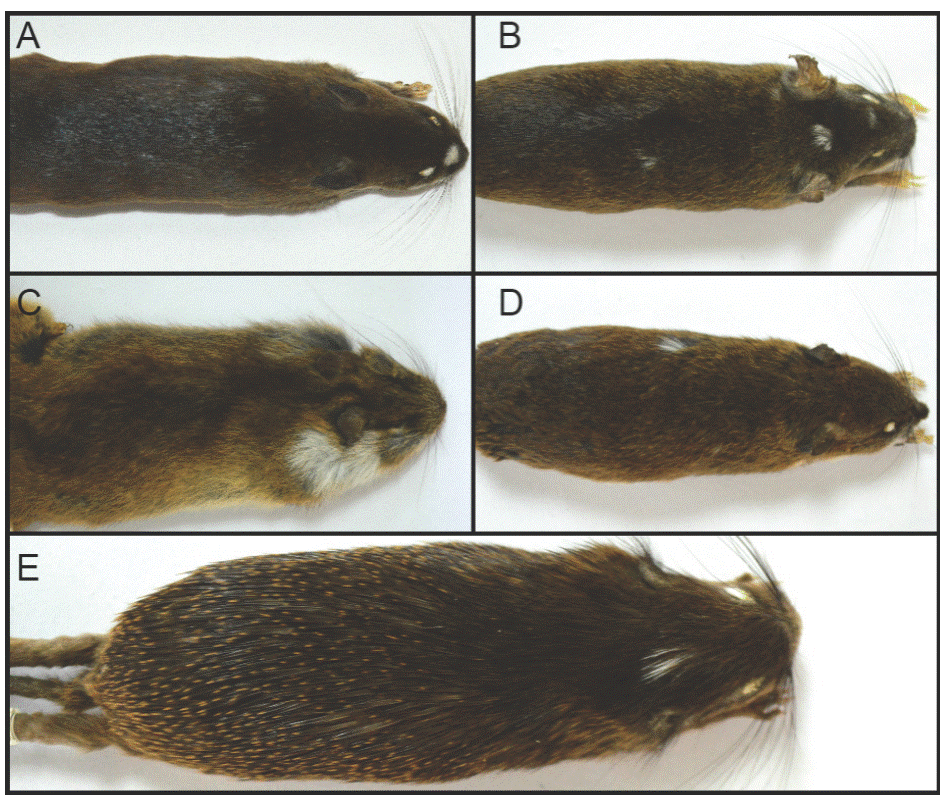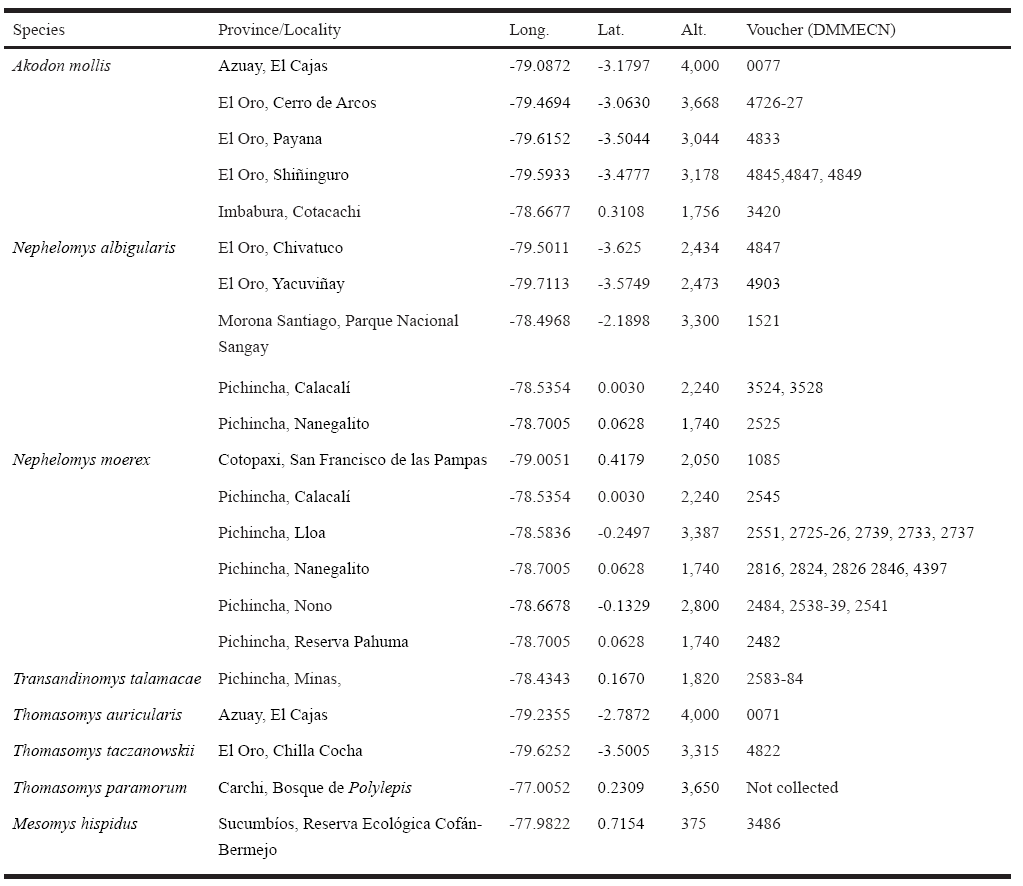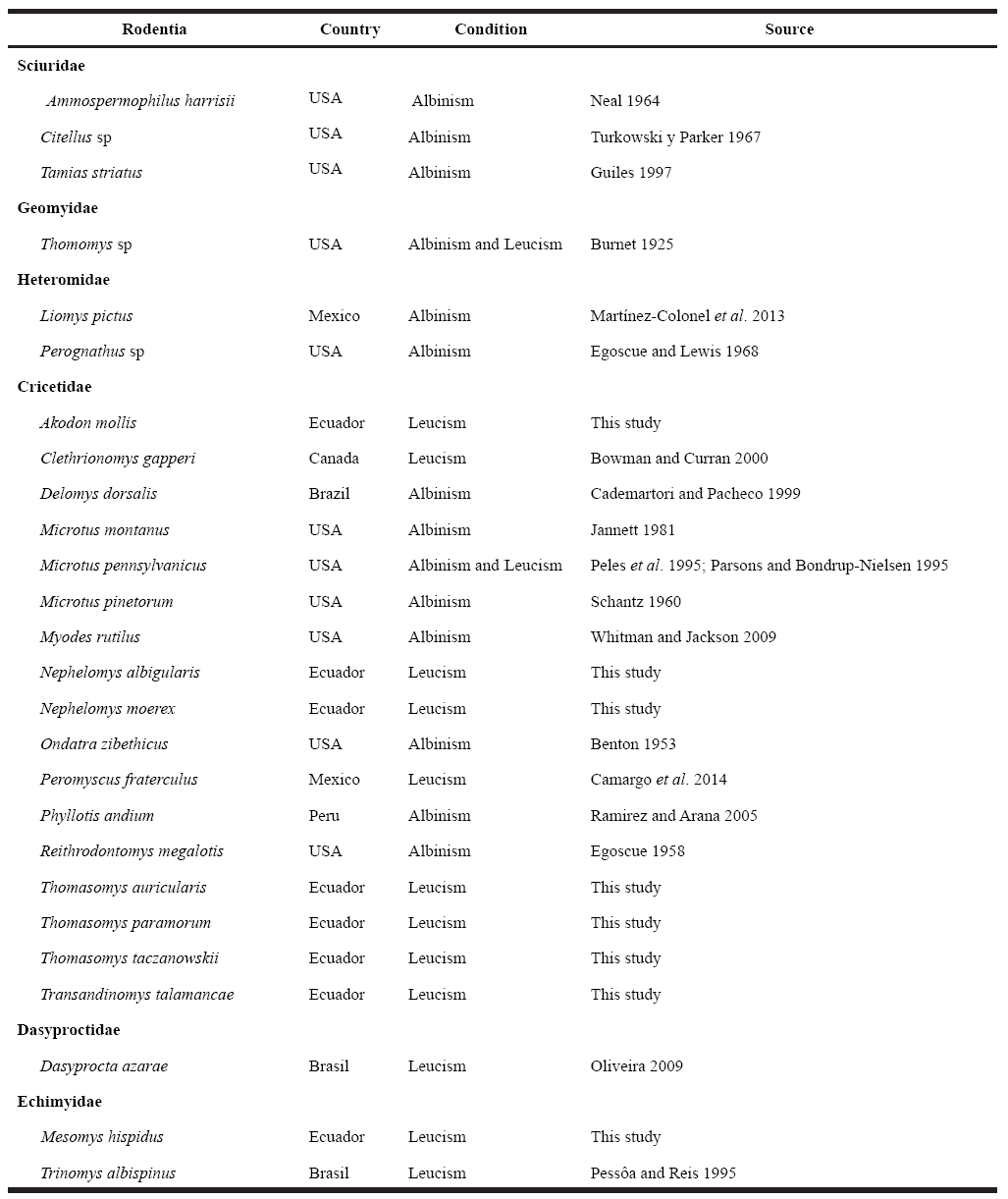Introduction
Abnormal coloration in mammals and other animals is considered as a hypopigmentary congenital disorder that reflects low genetic diversity levels; these chromatic aberrations are expressed mainly as albinism and leucism (Phillips 1954; Bensch et al. 2000). Leucism is expressed as the almost total decoloration of certain parts of the body, but preserving the typical color of eyes, nails and skin (Bensch et al. 2000; Miller 2005). The occurrence of leucism is associated with factors such as pollution, environmental alterations (Moller and Mousseau 2001), low-quality diet (Owen and Shimmings 1992; Peles et al. 1995), or follicular damage (Phillips 1954; Hafner and Hafner 1987). Individuals with leucism are more frequent in small and isolated populations due to inbreeding, which causes recessive alleles to be expressed (Holyoak 1978; Bensch et al. 2000).
Leucism is relatively rare in small mammals (Steen and Sonerud 2012), with only 18 cases of abnormal colorations reported in the American continent for the order Rodentia (Appendix 1). In South America, the genera Akodon, Nephelomys and Thomasomys, all of which include a wide variety of species, as well as Trasandinomys and Mesomys, with fewer species, are taxa for which albinism and leucism in wild specimens have not been previously reported.
In Ecuador only two cases of color aberrations in small mammals are known, one albine Vampyrum spectrum specimen (Brito and Leon 2014) and one Carollia perpicillata specimen with leucism (Boada and Tirira 2010); information on these conditions for other mammals is unknown. This note reports the first cases of leucism for several species of Ecuadorian rodents distributed mainly to the southwest and other areas of the country.
Materials and Methods
The study included several field trips to eight sites in 2015. The study area comprises the Cordillera de Chilla, southeastern Ecuador, between 2,434 m (-79.501° W, -3.625 °S) and 3,668 m (-79.469° W, -3.063° S). The study sites include natural habitats with human interventions: montane forests (visually dominated by Polylepis sp, Ocotea sp and several Melastomataceae species); and moorland shrub (visually dominated by Stipa sp, Calamagrostis sp and several shrub species of Asteraceae). The field work was framed within the project "Guide to the mammals of the El Oro province".
The systematic methodology for capturing small mammals consisted in the use of live traps (Sherman and Tomahawk). One hundred traps (90 Sherman and 10 Tomahawk traps, the latter interspersed every two and three stations) were arranged in transects of 15 and 25 stations, each station with two and six traps, usually with a separation of approximately 10 m between stations. The trapping effort was 1,650 trap-nights. The bait used was a mixture of oats flavored with vanilla and coconut essence. The reference specimens are deposited in the Museo Ecuatoriano de Ciencias Naturales, Instituto Nacional de Biodiversidad (DMMECN). Additionally, a review of the mammal collection of DMMECN was conducted in search of specimens with this anomaly.
Results
A total of 170 rodent specimens belonging to 11 species were captured in Cordillera de Chilla. In all, nine individuals (5.3 %) had leucism (Figure 1). Thirty nine individuals of the genus Akodon were captured, six (15.4 %) of which showed leucism. In the case of Nephelomys and Thomasomys (with 27 and 57 specimens captured, respectively), two (7.1 %) and one (1.8 %) individuals showed this condition. All specimens were captured in areas with native vegetation.

Figure 1 Rodents with leucism recorded in Cordillera de Chilla, southwestern Ecuador: A = Akodon mollis (DMMECN 4,847); B = A. mollis (DMMECN 4,849); C = A. mollis (DMMECN 4,833); D = A. mollis (DMMECN 4,845); E = Thomasomys taczanowskii (DMMEC 4,822); Polylepis forest in northern Ecuador: F = Thomasomys paramorum (not collected). Photographs J. Brito.
As regards the revision of voucher specimens (DMMECN), 29 showed leucism (Table 1); these belong to two families, five genera and seven species. Cricetids (Figure 2) of the genus Nephelomys (n = 23) accounted for most cases, while Akodon (n = 1), Transandinomys (n = 2), Thomasomys (n = 2), and Mesomys (n = 1) exhibited leucism to a lesser extent.

Figure 2 Voucher specimens with leucism: A = Nephelomys albigularis (DMMECN 3,624), B = N moerex (DMMECN 2,824), C = Thomasomys auricularis (DMMECN 71), D = Transandinomys talamacae (DMMECN 2,584) and E = Mesomys hispidus (DMMECN 3,486). Photographs K. Valdivieso-Bermeo.
The sum of leucism records in Cordillera de Chilla plus the voucher specimens amounts to 38 individuals of eight species: Akodon mollis (n = 7), Nephelomys albigularis (n = 7), N. moerex (n = 18), Transandinomys talamancae (n = 2), Thomasomys auricularis (n = 1), T. taczanowskii (n = 1), T. paramorum (n = 1), and Mesomys hispidus (n = 1).
Discussion
In southwestern Ecuador, Cordillera de Chilla is considered as an important bridge for the passage of wild animals between the Pacific slope, the Andes and the Amazon (Krabbe 2008); however, in the last decades natural habitats have been fragmented, with forests and moors being replaced by pasture and large areas of pine plantations. Today there are only small isolated remnants along the borders of ravines and rocky walls. Even the small ravine forests still existing are being disturbed by livestock that invades these areas to feed on herbs and tree bark. This situation is likely influencing the emergence of species with leucism, in agreement with Holyoak (1978), Bensch et al. (2000) and Lopucki and Mróz (2010), who state that the frequency of occurrence of Individuals with atypical colorations in a wild population is affected mainly by the isolation of populations.
The fragmentation of natural habitats in Cordillera de Chilla could be preventing gene flow between rodent populations, even in Akodon mollis, a terrestrial species that inhabits forests and moorland shrub, and which is usually tolerant to habitat modification. However, N. albigularis, a terrestrial rodent, and T. taczanowskii a rodent of semi-arboreal habits, both associated only with forests, also showed leucism, although in smaller numbers.
The present is the first report of leucism in eight rodent species of Ecuador. The museological reviews, field reports and studies on population genetics will contribute to understand the existence of spatial and temporal patterns, or demonstrate the indirect causes of these aberrations in natural populations.











 text new page (beta)
text new page (beta)




